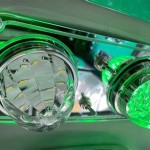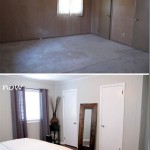How To Paint Interior Brick Wall: A Comprehensive Guide
Painting an interior brick wall can dramatically transform the aesthetic of a room, adding character, brightness, or a modern touch. While a seemingly straightforward task, achieving a professional and lasting finish requires careful preparation and execution. This article provides a comprehensive guide on how to paint an interior brick wall, covering essential steps from assessing the brick condition to applying the final coat of paint.
Before embarking on this project, it's crucial to understand that painting brick is a permanent decision. Removing paint from brick is a laborious and often damaging process. Therefore, consider the long-term implications and explore alternatives, such as whitewashing or staining, if a less permanent change is desired.
Preparing the Brick Wall: Cleaning and Repairing
Proper preparation is paramount for paint adhesion and longevity. The first step involves thoroughly cleaning the brick surface to remove dirt, grime, efflorescence, and any existing loose paint or debris. This process typically involves the following:
1.
Dry Brushing:
Use a stiff-bristled brush, preferably a scrub brush with nylon or wire bristles, to remove loose particles from the surface. Pay particular attention to crevices and mortar joints where debris may accumulate.2.
Vacuuming:
After dry brushing, vacuum the entire wall surface with a brush attachment to remove any remaining dust and debris. This ensures a cleaner surface for subsequent washing.3.
Washing:
Prepare a cleaning solution consisting of warm water and a mild detergent, such as dish soap. Avoid harsh chemicals or abrasive cleaners, as they can damage the brick or leave behind residues that interfere with paint adhesion. Apply the cleaning solution to the wall using a sponge or scrub brush, working in small sections. Rinse thoroughly with clean water to remove all traces of the detergent.4.
Efflorescence Removal:
Efflorescence, the white, powdery deposit that appears on brick surfaces, is a result of salt deposits migrating to the surface. If present, it must be removed before painting. A diluted muriatic acid solution (follow manufacturer’s safety guidelines meticulously, including wearing appropriate protective gear) can be used to neutralize and remove efflorescence. Apply the solution according to the manufacturer's instructions, rinse thoroughly with clean water, and allow the wall to dry completely before proceeding. Alternatively, a specialized efflorescence remover available at most hardware stores can be used.5.
Pressure Washing (optional):
For heavily soiled brick walls, a pressure washer can be used to expedite the cleaning process. However, exercise caution to avoid damaging the brick or mortar joints. Use a low-pressure setting and a wide-angle nozzle. Ensure the wall is thoroughly dry before proceeding to the next step.Following cleaning, inspect the brick wall for any signs of damage, such as cracks, crumbling mortar, or missing bricks. These issues must be addressed before painting to ensure a structurally sound and visually appealing finish.
1.
Mortar Repair:
Use a chisel and hammer to remove any loose or crumbling mortar. Clean the joints thoroughly and apply new mortar using a trowel. Ensure the new mortar matches the existing mortar in color and texture. Allow the mortar to cure completely according to the manufacturer's instructions before proceeding.2.
Crack Repair:
Small cracks in the brick can be filled with a masonry crack filler or sealant. Apply the filler according to the manufacturer's instructions and smooth it out with a putty knife. For larger cracks, consult a professional mason for advice on the appropriate repair method.3.
Brick Replacement:
If any bricks are severely damaged or missing, they should be replaced. Match the replacement bricks as closely as possible to the existing bricks in terms of size, color, and texture. Secure the new bricks with mortar and allow the mortar to cure completely.Once the cleaning and repairs are complete, allow the brick wall to dry thoroughly for several days, or even a week, before proceeding with priming and painting. The brick must be completely dry to ensure proper paint adhesion and prevent moisture-related issues.
Priming the Brick Wall: Selecting the Right Primer
Priming is an essential step in painting a brick wall. Primer serves several important functions:
1.
Sealing:
Primer seals the porous surface of the brick, preventing the paint from being absorbed excessively. This ensures uniform coverage and reduces the number of paint coats required.2.
Adhesion:
Primer provides a bonding layer between the brick surface and the paint, improving adhesion and preventing peeling or chipping.3.
Stain Blocking:
Primer can block stains, such as water stains or soot, from bleeding through the paint.4.
Alkali Resistance:
Brick is alkaline, and some paints can react with the alkalinity, causing discoloration or degradation. Primer provides a barrier against this reaction.The choice of primer is crucial for achieving optimal results. Several types of primers are suitable for brick walls:
1.
Alkali-Resistant Primer:
This type of primer is specifically formulated to resist the alkalinity of brick and mortar, preventing paint degradation. It is an excellent choice for new or unpainted brick walls.2.
Latex Primer:
Latex primers are water-based and offer good adhesion and sealing properties. They are suitable for interior brick walls that are not exposed to excessive moisture. Choose a high-quality 100% acrylic latex primer for best results.3.
Oil-Based Primer:
Oil-based primers offer excellent adhesion and stain-blocking properties. They are a good choice for brick walls that have been previously painted or have existing stains. However, oil-based primers have a longer drying time and require mineral spirits for cleanup. They also emit more VOCs (volatile organic compounds) than latex primers. They are generally less preferred due to environmental and health concerns.4.
Block Filler Primer:
For extremely porous or uneven brick surfaces, a block filler primer can be used. This type of primer is thicker than ordinary primer and helps to fill in pores and imperfections in the brick, creating a smoother surface for painting. However, block filler primers can be difficult to apply and may require multiple coats.Apply the primer evenly to the brick wall using a brush, roller, or sprayer. A brush is ideal for reaching into crevices and mortar joints, while a roller can be used to cover larger areas quickly. If using a sprayer, follow the manufacturer's instructions carefully and ensure proper ventilation. Apply one or two coats of primer, allowing each coat to dry completely before applying the next. Follow the manufacturer's recommended drying time.
Painting the Brick Wall: Selecting the Right Paint and Application Techniques
Once the primer has dried completely, it's time to apply the paint. The choice of paint is just as important as the choice of primer. Several factors should be considered when selecting paint for an interior brick wall:
1.
Type of Paint:
Acrylic latex paint is the most common and recommended type of paint for interior brick walls. It offers good adhesion, durability, and moisture resistance. Choose a high-quality 100% acrylic latex paint for the best results. Avoid oil-based paints, as they can become brittle and crack over time.2.
Sheen:
The sheen of the paint affects the appearance and durability of the finish. Flat or matte sheens provide a non-reflective finish that can hide imperfections but are less durable and more difficult to clean. Satin or eggshell sheens offer a balance between durability and appearance. Semi-gloss or gloss sheens are the most durable and easiest to clean but can highlight imperfections. For most interior brick walls, a satin or eggshell sheen is a good choice.3.
Color:
The color of the paint is a matter of personal preference. Consider the existing décor of the room and the desired aesthetic. Lighter colors can brighten a room, while darker colors can create a more dramatic effect.Before painting, protect surrounding surfaces, such as floors, ceilings, and furniture, with drop cloths and painter's tape. Stir the paint thoroughly to ensure uniform color and consistency. Apply the paint evenly to the primed brick wall using a brush, roller, or sprayer. Like with priming, a brush is ideal for reaching into crevices and mortar joints, while a roller can be used to cover larger areas quickly. If using a sprayer, follow the manufacturer's instructions carefully and ensure proper ventilation.
Apply two coats of paint, allowing each coat to dry completely before applying the next. Follow the manufacturer's recommended drying time. Pay particular attention to ensuring that the paint is applied evenly and that all crevices and mortar joints are fully covered. Avoid applying too much paint in one coat, as this can lead to drips and runs. If drips or runs do occur, use a brush to smooth them out before the paint dries.
Once the second coat of paint has dried completely, remove the painter's tape and drop cloths. Inspect the painted brick wall for any imperfections or touch-ups that may be needed. Clean up any paint spills or splatters with appropriate cleaner for the type of paint used (water for latex, mineral spirits for oil-based). Allow the paint to cure for several days before placing furniture or other objects against the wall.

How To Properly Paint Interior Brick Walls Burnett Painting Venice Fl

Painting A Fireplace Or Interior Brick Wall New Life

5 Things To Consider Before Painting Interior Brick Tuck Pointing And Chimney Repair Toronto Turnbull Masonry Ltd

Interior Brick Wall Ideas Painted Distressed Or Natural Watsontown

How To Paint Interior Brick Painting Guide

How To Paint Brick Bob Vila

How To Paint A Brick Wall Interior Painted Walls

How To Paint Interior Brick Archives Burnett Painting Venice Fl

The Pros And Cons Of Painting Brick Surfaces Servicewhale

How To Paint A Brick Wall And Unify Choppy Room Young House Love
Related Posts








